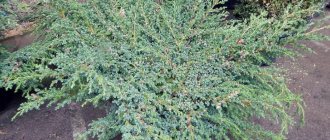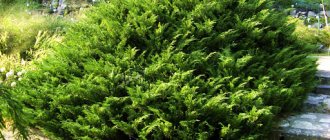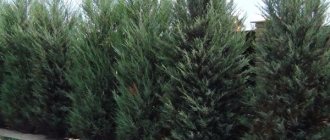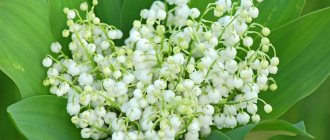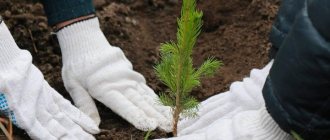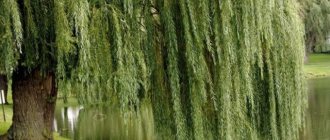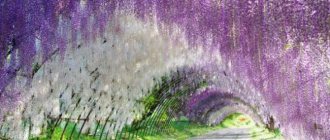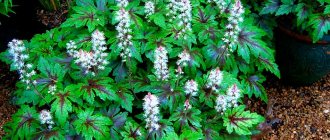General description of scaly juniper
Scaly juniper (Juniperus squamata) is a densely branched shrubby plant from the Cypress family. The shoots of the conifer are brownish-green, growing in different directions, the needles are usually silver-blue, up to 8 mm long in whorls of 3 pieces. The needles are prickly and hard.
Scaly juniper is characterized by spreading forms and dark shade of needles
It bears fruit - dark blue cones with a light waxy coating. In nature, conifer grows mainly in the mountains; it can be found in the Eastern Himalayas, China and Taiwan.
Important! The fruits of the plant are poisonous and not suitable for food consumption. When growing on the site, you need to make sure that children and pets do not feast on them.
Frost resistance, drought resistance
Scaly juniper is a heat-loving plant and belongs to zone 5B. At temperatures down to -26 °C it can winter without shelter, but in colder climates it freezes. It is best to cultivate ephedra in the Krasnodar region and the Caucasus, in the Astrakhan and Rostov regions, and in the Leningrad region. In the Moscow region it requires careful shelter, but in the Urals and Siberia it takes root rather poorly.
At the same time, the winter hardiness of the crop may vary depending on the variety. For example, the description of Dream Joy juniper states that the variety tolerates frosts down to -34 °C, that is, it can grow in climate zone 4.
The plant has average drought resistance. The species does not like waterlogging, but with a prolonged absence of moisture and increased dry air, it also begins to turn yellow and dry out.
Size and growth rate
In height, scaly juniper usually rises only 1.5 m, but can grow 2-2.5 m in width. Annual growth depends on the variety, but on average the plant gains 10 cm per season. The speed is determined by the growing conditions; ephedra develops best in well-lit areas and light limestone soils.
Scaly junipers for the most part do not grow more than 1.5 m
Types of scaly juniper
The plant is usually divided into types according to its shape. There are 2 types of scaly conifers:
- Creeping, such junipers usually do not exceed 40 cm in height, have curved drooping shoots that descend to the ground;
Creeping scaly junipers form the soil cover
- tree-like, the conifers rise above the ground by about 1.5 m, sometimes higher, straight shoots are directed upward, although they may droop at the ends.
Tree-like scaly junipers grow vertically upward
Both varieties of crops have similar growing requirements.
Planting juniper scaly
The main condition for quality planting is the correct choice of seedling. 3-4 year old plants take root well in containers with a closed rhizome, while the soil should be covered with moss, and the root system should not crawl out through the drainage hole.
The optimal planting time is from April to May or October, when the soil is sufficiently moist, which contributes to good rooting of the crop. Seedlings should be planted in an open area.
When planting juniper, you must follow some recommendations:
- The planting site should be well lit or in slight shade.
- A planting hole for an adult plant is dug with a diameter of approximately 70 cm, drainage made of expanded clay, broken brick or gravel is laid at the bottom in a layer of 20 cm, after which it is covered with fertile soil with sand in a 1:1 ratio and fertilizer for conifers. The distance between tall bushes should be up to 2 m, between compact bushes - up to 1-1.5 m.
- After 2 weeks, when the soil has subsided, place the seedling in the hole and sprinkle it with a mixture of earth and sand, taken in equal proportions.
- The young planting is watered regularly during the first 14 days after planting. Also, in the first year of life in a new place, the plant is covered for the winter so that the branches do not break under the weight of the snow cover.
Varieties of scaly juniper
The coniferous plant is represented by many ornamental varieties. The varieties differ from each other mainly in the shade of the needles and the shape of the bush.
Floreant
Juniper flake Floreant has a very interesting color. Its shoots are covered with hard bluish needles, but at the ends they are soft yellow, making the shrub look very elegant. The variety does not exceed 40 cm in height, and can grow up to 50 cm in diameter.
Grows best in light shade. If the sun is not direct, but there is sufficient light, the scaly juniper Floreant retains its brightest color.
Floreant tolerates polluted air well and can grow in city conditions or near roads
Golden Flame
Another bicolor juniper, Golden Flame, is a tall variety and can grow up to 1.8 m. The needles are needle-shaped, sharp, silver-blue, and the needles at the ends of the shoots are creamy-yellow. It is recommended to plant the variety in well-lit areas, since in the shade it loses its brightness.
Golden Flame grows up to 2.5 m in diameter
Blue Swede (Blue Swede)
Blue Swede reaches 1.5 m in height as an adult and spreads up to 2.5 m in width. The crown of the shrub is raised, cushion-shaped, the shoots are directed vertically upward, but hang down at the tips. The color of the needles is a rich bluish-green. In winter, the scaly juniper Blue Swede changes color and becomes silver.
Blue Swede has a very curvy outline
Little Joanna
Decorative juniper Little Joanna is a miniature variety and grows up to a maximum of 40 cm. The bush can spread up to 50 cm in width, but remains compact and has thick and prickly greenish-blue needles. It prefers to grow on slightly acidic soils and in partially shaded places, where it retains maximum color saturation.
Little Joanna tolerates light shade well
Dream Joy
The dwarf scaly juniper Dream Joy grows to only 50 cm in height. The crown of the shrub is wide-spreading, asymmetrical, yellowish-green in color with creamy patches of young needles. Scaly juniper Dream Joy is well suited for growing in a sunny flower bed. It can coexist with other plants because it is not prone to taking over territory.
Dream Joy can grow up to 90 cm in diameter
Blue Spider
The Blue Spider variety can reach 1 m in width, but at the same time rises only 30 cm even in adulthood. The shape of the bush is creeping, with a slightly convex middle; thin young shoots hang down to the ground. The color of juniper is silver-blue.
Blue Spider retains color best in lightly shaded areas
Lodery
Scaly juniper Loderi can grow up to 80 cm by 10 years of age. The needles of the shrub are needle-shaped and hard, bluish-green in color. The shoots grow vertically upward, so with regular pruning the variety can be given a beautiful candle shape.
Loderie gains about 10 cm per year
Gold Type
Variety Gold Tip is a low scaly juniper capable of reaching 70 cm in height and 120 cm in diameter. The shape of an adult shrub is a bit like a star; its young needles are yellowish and bright. As it develops, it changes color to green, with a slight silvery tint.
Gold Type is a hardy variety suitable for planting in the countryside and in the city.
Hannethorpe
Scaly juniper Hannetorp has a funnel-shaped crown and rises up to 1.5 m above the ground. Young shoots of the shrub are light green, soft, become tougher with age and acquire a gray-blue color. Hannethorp can spread up to 1.8 m in diameter and develops slowly.
Hannethorp has good hardiness and can grow in any soil.
Blue Star
Blue Star has a dense crown of turquoise-blue color. The height does not exceed 40 cm, but the diameter spreads widely, up to 2 m.
Blue Star grows quickly and requires regular crown formation
Chinese Silver
China Silver is a fairly tall juniper, up to 2.5 m tall and up to 3 m in diameter. The needles of the plant are blue, and the color does not change in winter; the shoots are spreading. The shrub prefers to grow in sunny places; it needs neutral and breathable soil.
Chinas Silver is considered one of the tallest scaly junipers
Blue Carpet
The miniature Blue Carpet reaches 40 cm in height and spreads up to 1.5 m. It belongs to the creeping ground cover type, the color of the needles is silver-blue.
Blue Carpet prefers to grow in partial shade
Tropical Blue
The decorative variety Tropical Blue is small in size, up to 30 cm in height and about 60 cm in diameter. The shrub's needles are silver-blue and look especially bright in illuminated areas. In the shade, the plant may lose color saturation.
Tropical Blue's needles are short and very dense.
Meyeri
Meyeri is one of the tallest scaly varieties. At maturity it can stretch up to 5 m, adding 10 cm per year. The needles of the shrub are dark green with a bluish tint.
Juniper Meieri requires regular pruning
Holger
The medium-sized Holger reaches 1 m above the ground and spreads up to 1.5 m. The needles are golden-green when young, and gray-blue when mature.
Holger - scaly juniper with flowing shoots
Main types
Breeders have developed many varieties of scaly juniper. The most popular varieties and hybrid forms include:
- Blue Carpet is a low shrub that creeps along the ground, reaching a height of about 60 cm by the age of 10. The branches flow down from the top of the crown and are covered with silver-blue needles. It is grown in rock gardens, alpine hills, and as a potted crop on verandas and balconies. The plant is light-loving.
- Golden Flame is a squat shrub with a spreading crown. Coniferous branches of a green shade with cream splashes. It grows quite slowly. Suitable for cultivation in central Russia.
- Floreant is a slow-growing shrub up to 1 m high and up to 2 m in diameter. The needles are green-yellow, and ocher spots spread chaotically throughout the bush. Planted in pots and as a hedge.
- Hunnetorp is a shrub with a beautiful and compact crown. The needles are in the form of small needles of a greenish-silver hue. This variety is cultivated in European and Scandinavian countries.
- Blue Star - has an irregular oval-shaped crown, grows up to 1 m in height. The needles are needle-shaped, bluish-green in color.
- Holger - the branches are very dense, horizontally and vertically directed. Needles of bluish-green tones.
- Meyeri is a creeping bush, with drooping stems about 1 m long. The branches are covered with soft bluish-green needles. With age, the needles acquire a bluish tint. It is the most capricious variety and requires shelter for the winter. Prefers nutritious, loose and well-drained soil. Used for decorating roofs.
Scaly juniper in landscape design
Photos of scaly juniper show that it is used very widely in garden design. The bush can be found:
- as a single plant;
Scaly juniper can decorate empty areas of the garden
- in artistic compositions;
Scaly juniper goes well with other conifers and perennials
- as part of alpine slides and rocky gardens;
Juniper grows well in dry soils and looks harmonious against the background of stones
- on the slopes.
Low varieties of juniper help decorate gently sloping areas and protect them from falling
Attention! Most varieties can be grown in flowerpots.
Methods of propagation of scaly juniper
There are several ways to increase the population of scaly juniper on your site:
- seeds;
- cuttings;
- layering.
It is most convenient to propagate scaly juniper by cuttings. Cuttings
are considered the most effective; the method is suitable for all varieties of the crop and allows you to obtain new specimens in a short time.
Reproduction
Juniperus virginiana can be propagated in the following ways:
- By seeds: seed material is subject to stratification before sowing. Shoots are expected in 1-3 years, after which young plants are grown in separate containers or in greenhouse conditions. They are transplanted to a permanent place of growth only at the age of three. When sowing from seeds, the decorative qualities of the variety are not always preserved.
- Cuttings: considered the most effective method. Cuttings are harvested in early spring or early summer. Planting material cut in spring takes root better. The workpieces are cut with a sterile instrument in cloudy weather, cleaned of bark and needles and placed in a nutrient substrate. Rooting occurs within 2-3 months.
- Layering: performed for horizontal or creeping varieties of scaly juniper. You should water the bush, loosen the soil, add humus and sand, remove the bark from the branch, bend it to the ground and secure it with a pin. The next year, when new roots form, disconnect from the mother bush.
Planting and caring for scaly juniper
It is recommended to plant scaly juniper on the site in early spring, immediately after the snow cover melts. The place for the conifer is chosen to be sunny, with light shading during the day; the soil should be slightly acidic or close to neutral. The plant requires loose, well-ventilated soil.
Young two-year-old seedlings take root best, and when purchasing, it is better to choose plants with a closed root system. Planting material should be healthy, with strong shoots, with uniform needles without yellow areas.
The landing algorithm looks like this:
- in the selected area, dig a hole about 70 cm deep and fill its bottom with pebbles or expanded clay to create drainage;
- half the hole is filled with turf soil mixed with sand, peat and humus;
- the seedling is watered abundantly and, together with the previous earthen lump, is lowered in the center of the hole;
- the remaining soil mixture is poured into the hole completely.
Attention! The root collar of tall scaly junipers is left 10 cm above the ground, and for compact ones it is level with the ground surface.
Immediately after planting, the plant is properly watered and mulched with sawdust or bark. There is no need to compact the soil in the tree trunk circle.
Growing a plant
You need to find a sunny place for the plant in the garden; slight shade is allowed during the day. All varieties of juniper react differently to the sun's rays. Therefore, before planting, you need to find out about the preferences of each variety.
The root structure is fragile, the roots are sensitive to any transplants. For transplantation, only the transshipment method is used.
The plant is transplanted to a new place only with a large lump of soil. Between tall or extensive juniper bushes, make a two-meter indentation.
If compact bushes grow and are up to one meter wide, then the distance between them can be reduced to 1-1.5 meters.
When a plant is transplanted from one place to another or planted from a pot after purchase, it is necessary to water the soil with water to soak it. Then it will be much easier to pull out the bush along with the soil.
The depth of the planting hole must be at least 70 cm. Drainage made of small building materials is laid at the bottom of the hole.
For example, pebbles, fine-grained expanded clay.
The soil that is removed from the hole is mixed with leaf humus, sand and peat soil.
Important: do not fill the root collar with soil. For small bushes it is covered with soil up to the ground level.
If the bushes are tall, then the root collar should protrude above the surface at a level of 10 cm. There is no need to compact the soil after planting. But it needs to be watered.
Almost all varieties of scaly juniper are unpretentious and will take root anywhere.
Care measures
Watering . Do not water when there is a normal amount of precipitation. If the weather is dry, then moisten once every two weeks. For one medium bush you need to pour three ten-liter buckets of water.
On the second day, after watering, the soil around the bush is loosened. They pull out weeds. A layer of mulch is applied around the trunk of the bush: peat, sawdust or tree bark. Evaporation of moisture will occur more slowly.
Early in the morning or late in the evening during the warm season, they simulate rain on the plants.
When the plants are small (in height and age), at noon you need to protect the branches from direct sunlight. Make shading over the bushes.
Trimming. They do the pruning very carefully. The branches grow slowly, so don't get too carried away with pruning. But sanitary pruning is needed. When working with juniper, you should wear gloves. The juice released during pruning can cause severe irritation on the hands.
Preparing for winter. Young bushes wrap themselves up for the winter. Use any covering: dry leaves, peat, sawdust, pine branches. If frost-resistant varieties are planted, then there is no need to cover them in winter for the next season.
Another article described Cossack juniper.
How to care for scaly juniper
Caring for coniferous crops is quite simple. It is important to adhere to the basic rules, moisten and trim the plant on time.
Watering and fertilizing schedule
Young scaly junipers require frequent watering, once every 1-2 weeks as the soil dries out. Adult plants have enough natural moisture, but on hot summer days it is useful to irrigate them with water along the crown.
Feeding for scaly conifers is usually carried out twice per season. In the spring, in April or May, nitroammophoska is added to stimulate shoot growth, and in the fall, organic matter, peat or humus is scattered at the roots of the plant.
Pruning scaly juniper
Scaly junipers are prone to chaotic growth, so decorative pruning is necessary for most varieties. But given the slow growth of conifers, it is carried out rarely, as needed, once every few years.
Sanitary pruning is carried out annually in early spring or autumn 1-1.5 months before the cold weather. During the process, all dry and broken shoots are removed, and the bush is also inspected for diseases and pests.
Pruning for scaly juniper is carried out in the spring before sap flow begins or in the fall
Advice! It is recommended to wear protective gloves when pruning the plant. Its juice is poisonous and can cause skin irritation.
Mulching, loosening the soil
To better retain moisture, it is customary to mulch the soil under scaly juniper. You can use bark, sawdust or peat; spread the material in a layer of about 5 cm.
Once a month, it is recommended to loosen the soil at the roots of the conifer. The procedure not only improves oxygen access, but also helps get rid of weeds and possible pest larvae in the soil.
Preparing for winter
Scaly juniper has average frost resistance and requires careful pre-winter preparation. In the middle or end of September, the plant should be watered for the last time so that the soil is properly saturated with moisture. After this, the conifer is mulched with humus or peat, the organic matter will serve as fertilizer and at the same time insulate the roots of the crop.
In the middle zone and cold regions, scaly juniper is covered for the winter, especially when young. For low-growing varieties, a frame is built that will not allow snow to break the shoots, and for tall varieties, branches are tied to the trunk.
Before the onset of winter, it is advisable to cover the juniper with non-woven material.
Choosing a juniper variety for planting
When choosing a type of juniper for planting in the garden, you must have complete information about its characteristics: winter hardiness, size of the plant as an adult, shape and color of the crown, growing conditions and care. Junipers, which are brought to us from Western European nurseries, can be both quite resistant to the harsh winters characteristic of central Russia, and non-winter-resistant, successfully growing without shelter only in the southern regions.
After purchasing a new coniferous plant (even a frost-resistant one), experienced gardeners recommend covering it for the first winter with spruce branches or burlap, tying up the branches to avoid sunburn of the needles and damage to the crown from snow.
Medium Gold Coast juniper, with its golden needles, contrasts impressively with the more emerald greenery
Employees of the Russian botanical gardens have identified juniper varieties suitable and unsuitable for cultivation in domestic latitudes.
Winter-hardy species of juniper (Juniperus):
- common (J. communis),
- Cossack (J. Sabina),
- scaly (J. Squmata),
- horizontal (J. horizontalis),
- Siberian (J. Sibirica),
- Chinese (J. Chinensis),
- hard (J. rigida),
- Virginian (J. Virginiana).
Non-winter-hardy types of juniper:
- Turkestan (J. Turkestanica),
- leaning (J. Procumbens),
- Zeravshan (J. Seravshanica),
- red (J. oxycedrus).
Successful rooting and growth of juniper largely depends on the quality of the purchased seedlings. When purchasing planting material, you should pay attention to the following points:
- It is better not to buy plants with an open root system.
- It is advisable to purchase juniper in a container or with an earthen lump wrapped in burlap.
- The root system and branches should show the current year's growth.
- There should be no cracks on the plant trunk.
- Fresh shoots should be flexible and unbreakable.
- The color of the crown should be uniform, without brownish inclusions and white flakes at the base of the needles.
- It is recommended to choose those plants that were grown in a container, rather than in open ground, and then simply transplanted into the container.
When choosing a juniper, do not be lazy to look at its coniferous neighbors. The most beautiful are:
Junipers with an open root system are planted in early spring or autumn, and seedlings with an earthen ball - throughout the entire period from spring to autumn. For the northern regions, planting in the spring is optimal - this way the seedling will have time to take root in order to more successfully survive the winter.
By combining junipers with different colored needles, you can form a hedge that is unusual in color and shape.
Pests and diseases of scaly juniper
With a lack of light or on wet soil, a coniferous plant may suffer from fungal diseases. It is especially often affected by:
- fusarium;
With fusarium, the roots are primarily affected, so the disease is almost impossible to treat.
- brown shutte;
When shutting down, the needles first become covered with a gray coating, and then turn brown, but do not fall off
- rust;
Rust is easily recognized by large orange growths on the shoots
- Alternaria blight.
With Alternaria blight, the trunk and needles turn brown and then turn black, and the tree dries out
When symptoms of disease appear, all affected shoots must be pruned and the bush treated with copper sulfate, Gamair or Fitosporin-M.
Important! Fusarium and rust are difficult to treat. If the plant does not respond to treatment, it is better to remove it from the site and burn it.
Among the pests that are dangerous for scaly juniper:
- spider mite;
In dry weather, spider mites can completely entangle juniper shoots
- aphid;
Small aphids are capable of covering juniper in large colonies
- sawfly.
Green and black sawfly caterpillars eat juniper needles
When infested with insects, insecticides are used for treatment, for example, Karbofos and Actellik. Treatment is carried out three times per season with breaks of about 20 days.
Why does scaly juniper turn yellow, what to do
Yellowing of scaly juniper can be caused by several reasons:
- Fungal diseases - Schutte, Alternaria, rust. The first symptom of most ailments is a change in the color of the needles; in such a situation, it is necessary to inspect the plant and spray it with fungicidal preparations.
- Lack of moisture, the bush tolerates short drought well, but with a long absence of water it begins to turn yellow and dry out. In this case, you need to reconsider the care and moisturize the ephedra more often.
- The soil is too acidic or alkaline, if the pH in the area deviates greatly from neutral, you need to spill the soil with malic acid or add lime to it.
- Ultraviolet burns; in the spring, junipers often burn in the bright sun. To prevent yellowing, you need to cover the conifers with non-woven material in late February or early March.
Juniper shoots may turn yellow due to drought, burns and diseases
Attention! The plant may suffer from cat and dog “marks” - the urine of pets strongly alkalizes the soil. To scare away pets, you can place dry barberry thorns near the conifer.
Plant care
After planting in the soil, seedlings require constant care, consisting of:
- moderate soil moisture;
- removal of weeds;
- fertilizers;
- covering the soil with a layer of mulch of at least 4 cm;
- additional shelter for seeds and sprouts for the winter;
- carrying out preventive measures to combat diseases and pests.
Feeding with fertilizers
Scaly juniper is a fairly unpretentious plant; it does not need to be fed intensively. Fertilizing with compost, nitrogen preparations or complex granular mineral fertilizers two to three times a year will be sufficient. It would not be superfluous to additionally spray the plant needles with microfertilizers, which will help them maintain their brightness for a longer time.
Important! Cow or bird humus can cause juniper roots to burn and the plant itself to perish. Loosening the soil around this plant can also cause the crop to wilt due to damage to its superficial root system. Juniper will be quite satisfied with mulching the soil.
Winter care
In winter, the crown of the juniper can darken, fall off, the bark of the formed plants can crack, which over time can lead to the death of the entire bush, so scaly juniper requires special attention in winter:
- Some varieties of scaly juniper are more frost-resistant, others less so, but it would not be superfluous to cover them all for the winter. Spruce branches are suitable for this (they are fixed to the crown in stages in tiers, starting from the bottom of the bush), woven and non-woven wrapping (burlap, light cotton, kraft paper), insulating material, which is used in construction for laying laminate flooring, is also suitable for covering small bushes and the snow itself;
- mature plants should be pre-tied at the end of autumn so that the spreading branches do not break under the weight of the snow cover;
- some varieties of juniper are sensitive to sunlight activity in winter and spring, which can lead to premature browning of the needles and even burns, therefore it is recommended to additionally install a screen with a reflective function on the most illuminated side;
- Overwintered branches damaged by frost should be pruned in the spring to a healthy place and these areas should be treated with garden varnish.
It is unacceptable to use plastic film to cover juniper for the winter, as the crop will be blocked and lost.
Prevention of diseases and pests
Juniper is very rarely subject to disease or attack by pests, but it still happens.
Diseases that pose a danger to this crop:
- rust is a fungus that appears as rust-colored spots on the crown. Affected branches should be removed and burned, the entire plant should be treated with fungicides “Vectra”, “Skor” and others. To avoid such problems, juniper should grow at a distance from the fruit trees from which it becomes infected; spraying with Arcerida solution every one and a half weeks can also help;
- Schutte is a fungus that appears with the arrival of summer and manifests itself in yellowing and covering last year’s needles with blackish spots. Damaged branches need to be removed and burned, the plant should be treated with fungicides “Strobi”, “Quadris” and others;
- Drying of the crown most often occurs in winter if the plant is not protected from active sunlight. As a result, intense photosynthesis begins in the needles, food for which cannot be obtained from the roots in the frozen ground. To avoid this, you need to protect the plants from excessive sun;
- Drying of branches is possible if the planting site is chosen incorrectly (thickened, with heavy soil and stagnant water), as a result of which fungal diseases appear. The affected branches should be removed and burned (if the affected area is large, the entire bush must be uprooted), treated with fungicides “Gamair”, “Fitosporin” and others. For the purpose of prevention, treatment with these drugs should be carried out every autumn;
- Fusarium and Alternaria are fungal diseases, for the prevention and control of which it is necessary to use only disinfected instruments, treat the resulting damage with copper sulfate and fungicidal preparations.
Insects that pose a potential danger to representatives of juniper crops:
- spider mites , which can be combated by treatment with a solution of the drug “Karate” at the rate of 55 g of product per ten-liter bucket of water;
- aphids , which can be gotten rid of by treating every 2 weeks with “Fiotoverm” (2 g per liter of water);
- juniper moth - destroyed with a solution of the drug "Decis" (2.5 g per ten-liter bucket of water);
- scale insects - treated with Karbofos (70 g per ten-liter bucket of water).
